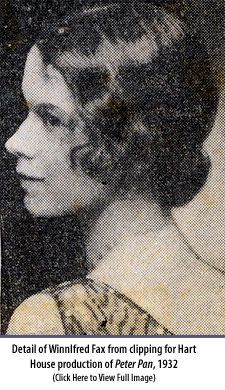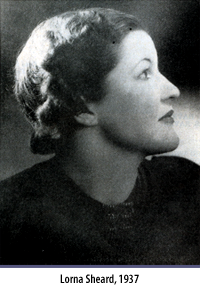| |||||||

 This was the scene that Sutcliffe entered when she began her dance studies at the Margaret Eaton School of Literature and Expression around 1922. Here she studied with Mildred Marsh, Winnifred Fax and Phyllis Strathy. Marsh was a graduate of the Margaret Eaton School where she had studied Louis Chalif's method of Russian ballet; she had also received training in New York at the Vestoff-Serova School of Dancing. Strathy was also a graduate of the Margaret Eaton School. Fax came from a family of vaudeville performers, but where she might have received formal dance training is unclear. Sutcliffe performed in a number of shows with Strathy and Fax during the 1930s and correspondence indicates that she maintained ties with Mildred Marsh into the 1940s.
This was the scene that Sutcliffe entered when she began her dance studies at the Margaret Eaton School of Literature and Expression around 1922. Here she studied with Mildred Marsh, Winnifred Fax and Phyllis Strathy. Marsh was a graduate of the Margaret Eaton School where she had studied Louis Chalif's method of Russian ballet; she had also received training in New York at the Vestoff-Serova School of Dancing. Strathy was also a graduate of the Margaret Eaton School. Fax came from a family of vaudeville performers, but where she might have received formal dance training is unclear. Sutcliffe performed in a number of shows with Strathy and Fax during the 1930s and correspondence indicates that she maintained ties with Mildred Marsh into the 1940s.
In 1926, Sutcliffe was studying ballet at Leon Leonidoff and Florence Rogge's Russian Ballet Studio on Jarvis Street. With Leonidoff's work choreographing dances for shows at the Hippodrome on Queen Street and the Uptown on Yonge, Sutcliffe probably saw greater potential for finding paid performing opportunities by studying with Leonidoff than if she remained at the Margaret Eaton School. It was known that he and Rogge pulled dancers from their classes to perform in the shows they were staging. For example, a program from the Hippodrome c. 1926 for a Christmas pantomime production of Jack and the Beanstock lists Sutcliffe as part of the ballet and chorus. Prior to this show, she had performed as a "Ballet Girl" in Bertram Forsyth's production of his play Castles in the Air - a children's play that debuted at Hart House during the Christmas holidays. She had also danced in Mildred Marsh's recitals in 1923 and 1924, and a Winnifred Fax recital in 1925. Another Hart House production in which she participated was Turandot, Princess of China directed by Walter Sinclair in the 1925/26 season.
 The house programs for these performances early in Sutcliffe's career begin to reveal the connections between the players in Toronto's 1920s and 1930s arts scenes. When Sutcliffe performed in Bertram Forsyth's Castles in the Air, it was during his second season as director of Hart House Theatre having replaced the theatre's first director Roy Mitchell. Forsyth was Oxford trained and had been a member of the Drama Society there. He had mounted several of his own plays by the time he arrived at Hart House and had considerable experience as a professional actor in England. He was notable for his skill at training actors and for his interest in mounting Canadian plays, which was one of the original goals of Hart House Theatre. He remained at Hart House for four seasons and then began working at the Margaret Eaton School in 1925. He subsequently moved to New York where he committed suicide in 1927. Forsyth's Castles in the Air had a strong musical component composed and directed by Healey Willan. Willan had established a career as a church musician, organist and choir director in England when he was offered a job as the Head of Theory at the Toronto Conservatory of Music in 1913; he was also vice-principal there from 1920-1936 and was a lecturer at the University of Toronto. From 1919-1925, he was the music director at Hart House where he wrote and conducted music for fourteen plays. In terms of the performers for Castles in the Air, Sutcliffe's teacher Winnifred Fax performed in several dancing roles in this production. Vincent Massey played "The Enchanter of Karibanou" and H.E. Hitchman, a prominent character actor of the time, played "The Wizard of Al-Bazan". Solos were sung by Pearl Whitehead who would later contribute to the founding of The National Ballet of Canada. Sets and many of the costumes were designed by students of the Ontario College of Art in the school's stagecraft course.
The house programs for these performances early in Sutcliffe's career begin to reveal the connections between the players in Toronto's 1920s and 1930s arts scenes. When Sutcliffe performed in Bertram Forsyth's Castles in the Air, it was during his second season as director of Hart House Theatre having replaced the theatre's first director Roy Mitchell. Forsyth was Oxford trained and had been a member of the Drama Society there. He had mounted several of his own plays by the time he arrived at Hart House and had considerable experience as a professional actor in England. He was notable for his skill at training actors and for his interest in mounting Canadian plays, which was one of the original goals of Hart House Theatre. He remained at Hart House for four seasons and then began working at the Margaret Eaton School in 1925. He subsequently moved to New York where he committed suicide in 1927. Forsyth's Castles in the Air had a strong musical component composed and directed by Healey Willan. Willan had established a career as a church musician, organist and choir director in England when he was offered a job as the Head of Theory at the Toronto Conservatory of Music in 1913; he was also vice-principal there from 1920-1936 and was a lecturer at the University of Toronto. From 1919-1925, he was the music director at Hart House where he wrote and conducted music for fourteen plays. In terms of the performers for Castles in the Air, Sutcliffe's teacher Winnifred Fax performed in several dancing roles in this production. Vincent Massey played "The Enchanter of Karibanou" and H.E. Hitchman, a prominent character actor of the time, played "The Wizard of Al-Bazan". Solos were sung by Pearl Whitehead who would later contribute to the founding of The National Ballet of Canada. Sets and many of the costumes were designed by students of the Ontario College of Art in the school's stagecraft course.
 The production of Turandot was directed by Walter Sinclair who had replaced Forsyth becoming Hart House Theatre's third director. Sinclair had been director of the Amateur Dramatic Club of Hong Kong; he was also a businessman and managed to bring some financial stability to the theatre during his tenure. Turandot was the fiftieth play produced at Hart House and featured Lorna McLean in the title role with Ernest MacMillan directing the music. Alison Sutcliffe, along with her former teacher Winnifred Fax and three others, was a harem dancer. Frederic Manning, who appears in numerous house programs in Sutcliffe's collection, sang as a soloist. Manning seems to have been a busy performer in Toronto in the 1920s and 1930s appearing as a singer and actor in productions of the Town Tonics with Jane Mallett, the Toronto Children Players with Dorothy Goulding, opera productions and various plays at Hart House; he also gave singing lessons. Another local dancer to grace this production was Claire Nesbitt who was a pupil of the highly reputable Toronto teacher Amy Sternberg and had danced in several of Sternberg's recitals in the late teens and early twenties. Cecil DaCosta, a local ballroom teacher and a future employer of Sutcliffe's, danced in the production and played the role of a "Eunuch"; the duet he danced was performed with another Sternberg student, Rita Davies. One of Sinclair's assistants was Brian Doherty who would go on to found the Shaw Festival in Niagara-On-The-Lake in 1962.
The production of Turandot was directed by Walter Sinclair who had replaced Forsyth becoming Hart House Theatre's third director. Sinclair had been director of the Amateur Dramatic Club of Hong Kong; he was also a businessman and managed to bring some financial stability to the theatre during his tenure. Turandot was the fiftieth play produced at Hart House and featured Lorna McLean in the title role with Ernest MacMillan directing the music. Alison Sutcliffe, along with her former teacher Winnifred Fax and three others, was a harem dancer. Frederic Manning, who appears in numerous house programs in Sutcliffe's collection, sang as a soloist. Manning seems to have been a busy performer in Toronto in the 1920s and 1930s appearing as a singer and actor in productions of the Town Tonics with Jane Mallett, the Toronto Children Players with Dorothy Goulding, opera productions and various plays at Hart House; he also gave singing lessons. Another local dancer to grace this production was Claire Nesbitt who was a pupil of the highly reputable Toronto teacher Amy Sternberg and had danced in several of Sternberg's recitals in the late teens and early twenties. Cecil DaCosta, a local ballroom teacher and a future employer of Sutcliffe's, danced in the production and played the role of a "Eunuch"; the duet he danced was performed with another Sternberg student, Rita Davies. One of Sinclair's assistants was Brian Doherty who would go on to found the Shaw Festival in Niagara-On-The-Lake in 1962.
In the recitals of Mildred Marsh and Winnifred Fax, Sutcliffe performed a variety of dances including Slavic dances, a Ballet of Flowers, Lavender and Old Lace, Schubert Suite, Sylvan Scenes, Nature Studies, Chopin Waltz, and The Swing (a duet with Helen Richardson), Chopin's Minute Waltz, a solo titled Moment Musicale, and a dance called Russian Couple. Other dancers include Phyllis Strathy; Helen Richardson whose daughter, Linda Stearns, would become a well-known ballet dancer, ballet mistress and artistic director of Les Grands Ballets Canadiens; Jean Macpherson who became a notable Toronto ballet teacher in the 1930s; and Bernadette Fisher who, under her married name of Bernadette Carpenter, was well known to Canadian dance teachers in the 1950s for her Shop for Dancers, a mail-order dance supplies company based in Toronto. Another notable performer is Lorna McLean (later Sheard) who contributed to numerous productions at Hart House Theatre as a choreographer, director and performer; McLean also helped to create the Experimental Group of Hart House Theatre in 1931, which fell under the direction of Dorothy Goulding in 1933 and was later called the Toronto Children Players. Both McLean's and Goulding's careers intersect with that of Alison Sutcliffe at many points in the 1930s.

In the fall of 1927, Sutcliffe auditioned for the corps de ballet of New York's Metropolitan Opera Company and danced there for three seasons under the direction of Rosina Galli. A contract from 1929 indicates that she worked a twenty-four-week season and was paid $20 per week for rehearsals and $28 per week for performances. When the stock market crashed in October of 1929, Sutcliffe decided it was time to leave.
![]()
©2008, Dance Collection Danse
Alison Sutcliffe Exhibition Curator: Amy Bowring
Web Design: Believe It Design Works
Sutcliffe and Rogge, c.1925
Leonidoff and Rogge brochure
Rosina Galli,
c. 1929
Sutcliffe at New York's Metropolitan Opera Company, c. 1927





